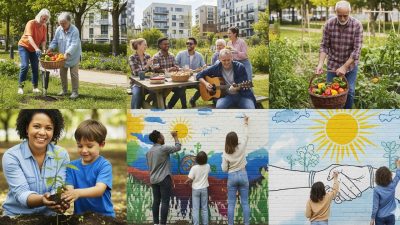The digital age promised to connect us like never before, yet many online communities struggle with a persistent problem: shallow connections. Members join with enthusiasm, engage briefly, then fade into digital silence. This phenomenon creates communities that feel more like passing crowds than genuine gathering places.
The root of this challenge lies in how most online platforms encourage interaction. Quick likes, brief comments, and surface-level exchanges dominate our digital conversations. While these interactions feel satisfying in the moment, they rarely build the meaningful relationships that transform casual visitors into devoted community members.
Understanding the Shallow Connection Problem
Surface-level engagement creates an illusion of connection without the substance. Members might recognize usernames and exchange pleasantries, but they lack deeper knowledge about each other’s experiences, challenges, and perspectives. This shallow foundation makes communities vulnerable to member churn and reduces overall engagement quality.
Traditional community platforms exacerbate this issue by prioritizing real-time interaction. The pressure to respond immediately often leads to hasty, unconsidered responses. Members feel compelled to contribute something, anything, rather than taking time to craft thoughtful contributions that could spark meaningful dialogue.
The consequences extend beyond individual relationships. Communities built on shallow connections struggle to develop shared culture, collective memory, and the trust necessary for members to share vulnerable experiences or seek genuine support.
The Power of Asynchronous Shared Experiences
Asynchronous shared experiences offer a compelling solution to this widespread problem. Unlike real-time interactions that demand immediate presence and quick responses, asynchronous experiences allow members to participate meaningfully on their own schedules while still creating genuine connections with others.
These experiences work by creating common reference points that members can explore, reflect upon, and discuss over extended periods. Rather than rushing through interactions, participants have time to process information, consider their responses, and contribute more thoughtfully to community conversations.
The beauty of this approach lies in its accommodation of different learning styles, time zones, and life circumstances. A working parent can engage deeply with community content after children are asleep, while a student might participate between classes. Everyone contributes when they can offer their best thinking.
Practical Implementation Strategies
Book clubs represent one of the most successful examples of asynchronous shared experiences in online communities. Members read the same material independently, then come together to discuss insights, reactions, and interpretations. The shared reading experience creates natural conversation starters and reveals different perspectives on common themes.
Challenge-based experiences also foster deeper connections. Month-long photography challenges, skill-building courses, or personal development programs give members parallel journeys to discuss. Participants share struggles, celebrate victories, and offer encouragement based on their own experiences with similar challenges.
Documentary or podcast series provide another avenue for meaningful shared experiences. Communities can watch or listen to content independently, then engage in rich discussions about themes, personal connections, and diverse interpretations. These conversations often reveal personal stories and values that strengthen member relationships.
Building Authentic Engagement Through Time
The temporal aspect of asynchronous experiences creates space for authentic engagement to develop naturally. Without the pressure of immediate response, members can share more vulnerable stories, ask deeper questions, and offer more considered support to others.
This approach particularly benefits introverted community members who might struggle with fast-paced real-time discussions. Having time to process and formulate responses allows all personality types to contribute meaningfully rather than defaulting to quick, surface-level interactions.
The extended timeline also allows relationships to develop organically. Instead of forced networking-style introductions, members discover commonalities and differences through shared experiences. These discoveries feel more natural and create stronger foundations for ongoing relationships.
Creating Lasting Community Bonds
Successful implementation requires intentional design and consistent facilitation. Community leaders must carefully select experiences that resonate with member interests while challenging them to think deeply about relevant topics. The chosen experiences should connect to community values and goals while remaining accessible to members with varying backgrounds.
Facilitation plays a crucial role in transforming shared experiences into lasting connections. Skilled moderators ask probing questions, highlight interesting member insights, and draw connections between different perspectives. They create space for all voices while maintaining focus on deeper engagement rather than surface-level chatter.
Documentation of shared experiences helps build community memory and culture. When new members can read about past experiences and the insights they generated, they gain understanding of community values and conversation norms. This historical context helps newcomers integrate more quickly and meaningfully.
For communities serious about building deeper member relationships, BuildBonding offers strategies and tools specifically designed to transform surface-level interactions into meaningful connections.
Measuring Success Beyond Numbers
Traditional community metrics focus on quantity: number of posts, comments, and active users. While these numbers matter, they don’t capture the quality improvements that asynchronous shared experiences provide. Communities should also track relationship depth, member retention over longer periods, and qualitative feedback about member satisfaction.
Look for signs of increasing vulnerability in member sharing, more detailed and thoughtful responses to community discussions, and members referencing past shared experiences in current conversations. These indicators suggest that shallow connections are evolving into meaningful relationships.
The ultimate measure of success comes when community members begin forming connections and collaborations outside the formal shared experiences. When members start their own discussion threads based on insights from shared experiences, or when they reach out to support each other during personal challenges, the community has transcended the shallow connection trap.
Building deeper connections in online communities requires patience, intentionality, and commitment to experiences that prioritize depth over speed. Asynchronous shared experiences provide the framework for this transformation, but success depends on consistent application and skilled facilitation.
The investment pays dividends in the form of more engaged members, stronger community culture, and relationships that extend far beyond digital boundaries. In an age of endless shallow interactions, communities that prioritize meaningful connection will stand out as truly valuable gathering places for their members.





